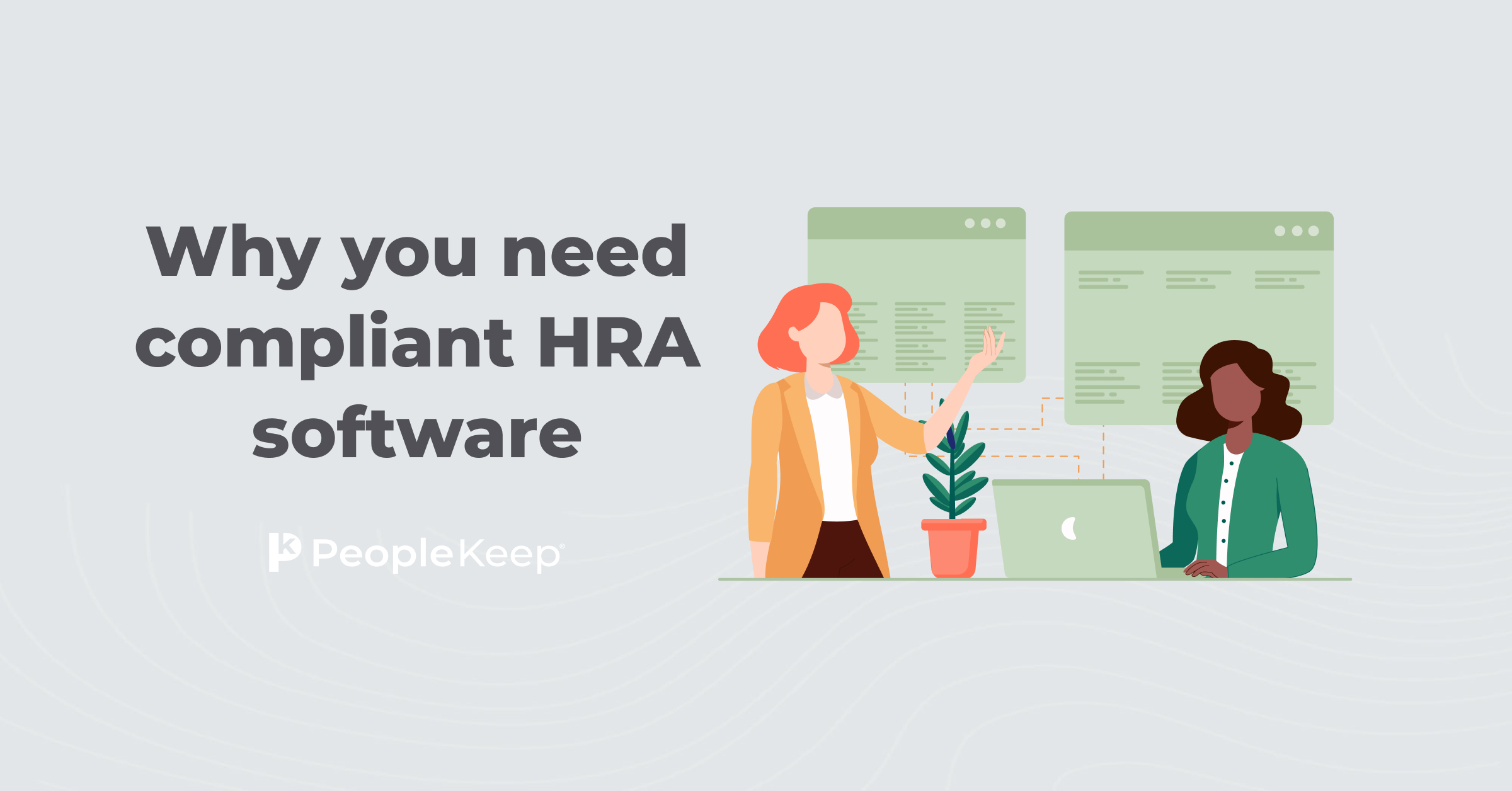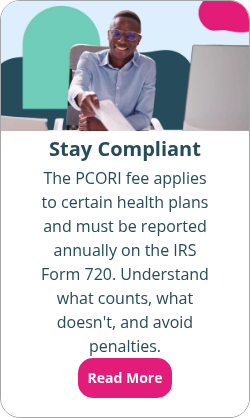What is Form 1095?
By Chase Charaba on January 13, 2025 at 11:15 AM
The Affordable Care Act (ACA) created new reporting requirements for health insurance. One responsibility for employers and insurers is completing Form 1095, which details the coverage they provide to employees.
But how do business owners know which version of the Form they should file? While you should consult with a tax professional if you have specific questions about filing one for your organization, we’ll go over general information about Form 1095 to help get you started.
In this blog post, you’ll learn:
- The purpose and importance of Form 1095.
- The differences between Forms 1095-A, 1095-B, and 1095-C.
- The filing deadlines, penalties for non-compliance, and steps employees can take if they don’t receive the required Form 1095.
What is Form 1095?
Form 1095 is a set of tax documents that employers and health insurers use to report information about health coverage on an individual’s income tax return. They serve as proof of insurance for tax returns and help determine if a health plan meets various ACA requirements.
The 1095 forms also ensure that individuals who purchase insurance through the ACA marketplace receive their eligible premium tax credits.
The document has three variations:
- Form 1095-A
- Form 1095-B
- Form 1095-C
Form 1095 also assists the Internal Revenue Service (IRS) in verifying whether an employee has adequate employer-sponsored coverage. This helps the IRS ensure applicable large employers (ALEs) have complied with the employer mandate or if they’re subject to shared responsibility payments.
What are the different types of Form 1095, and when should you use them?
There are three main types of Form 1095 that individuals, employers, and insurers may use to report their healthcare coverage.
The table below summarizes which plans require each type of Form:
|
Plan type |
Who provides the tax form |
Form |
|
Single coverage or family coverage from a public exchange, such as the Health Insurance Marketplace or a state-based exchange |
State or federal exchange |
1095-A |
|
Group health insurance and other employer-sponsored group health benefits |
Employers with fewer than 50 full-time equivalent employees (FTEs) and health insurance companies |
1095-B |
|
Medicare or Medicaid |
Department of Health and Human Services (DHHS) |
1095-B |
|
Children’s Health Insurance Program (CHIP) |
Department of Health and Human Services (DHHS) |
1095-B |
|
Group health plans and other employer-sponsored group health benefits |
Employers with 50 or more FTEs |
1095-C |
Form 1095-A
Insurance companies participating in the Health Insurance Marketplace and state-based exchanges provide information for Form 1095-A1. Also called the Health Insurance Marketplace Statement, the Marketplace completes and sends this form to individuals with qualified health plans bought on public exchanges. Employers don’t send employees the 1095-A form.
The Health Insurance Marketplace Statement contains vital information about an individual’s health coverage through the Marketplace in the previous year.
It includes details such as:
- The Marketplace identifier, assigned policy number, and the name of the health insurance issuer
- The individual’s name, Social Security number, date of birth, and address
- The individual’s spouse’s name, if applicable
- The individual’s coverage start and end dates
- The names, SSNs, dates of birth, and coverage start and end dates for any other covered individuals (dependents)
- The monthly enrollment health insurance premiums
- The monthly cost of the second-lowest-cost silver plan premium
- Any monthly premium tax credits they were entitled to, and if they used advance payments to pay for their premiums.
Individuals use this form to complete their federal income tax returns and reconcile any tax credit payments. Once they have their 1095-A and know the second-lowest-cost silver plan premium, they can complete Form 8962 for their premium tax credit2.
Only individuals with qualifying Marketplace coverage at any point during the year require a Form 1095-A. Health insurance providers supply the form even if the individual has no premium tax credits. Individuals with catastrophic health plans don’t receive the form.
Individuals don't need to attach Form 1095-A to their tax return. But, they should keep it for their records.
Form 1095-B
Health insurance carriers and employers with fewer than 50 FTEs that offer employer-sponsored health coverage send Form 1095-B to individuals and employees3. This includes insurers outside the Marketplace, government programs, and small businesses with self-insured health coverage.
The form reports the type of health insurance coverage an individual has, any dependents covered by the policy, and the coverage period for the prior year. The IRS also uses the form to verify that the individual and their dependents have had minimum essential coverage (MEC).
The Form includes the following:
- The individual’s name, SSN, date of birth, and mailing address
- Letter code for the origin of the health coverage
- A: Small Business Health Options Program (SHOP) marketplace
- B: Employer-sponsored coverage
- C: Government-sponsored program
- D: Individual market insurance
- E: Multiemployer plan
- F: Other designated MEC
- G: Individual coverage health reimbursement arrangement (ICHRA)
- The employer’s name, EIN, and address if this is for employer-sponsored coverage
- The insurance provider’s name, EIN, contact information, and address
- The type of coverage an individual had
- If the plan covered any dependents during the year
- The period of coverage
Individuals then use this form to verify that they had MEC on their tax returns to comply with the individual mandate. As of 2019, the IRS no longer penalizes people for not meeting the mandate. But, five states and the District of Columbia still have their own individual mandates. So, individuals in these locations must comply with state regulations to avoid costly fines.
For 2025, the IRS automatically extended the deadline to submit Form 1095-C to your employees from January 31 to March 3. No extra extensions are allowed.
However, the 2025 deadline to file Form 1095-B with the IRS is February 28 for paper filing or March 31 if filing electronically. You’ll also need to submit Form 1094-B by the same deadline. This form summarizes all your 1095s.
Like Form 1095-A, individuals don't need to attach the 1095-B form to their tax return. But they should keep it on file for their records.
Form 1095-C
As a result of the employer mandate, employers with 50 or more FTEs must offer health coverage to at least 95% of their full-time employees. Known as applicable large employers (ALEs), these employers use Form 1095-C to show the coverage they offered to their employees4.
It includes key details about your health insurance plan, including employee participation and eligibility information.
You include the following details on the form:
- The employee’s name, SSN, and address
- Your organization’s name, EIN, address, and contact information
- The employee’s age as of January 1
- The starting month for your plan
- The type of coverage you offered to an employee (using codes)
- The employee’s share of the monthly premium
- Section 4980H safe harbor and other relief codes
- The employee’s ZIP code for each month
- Any other covered individuals and the months your plan covered them
You must include one of the following codes for each month on the form to explain the type of coverage you offered your employees and how you determined affordability:
|
Code |
Code description |
|
1A |
You offered MEC that meets the minimum value (MV) standard to the employee with a required employee contribution that’s less than or equal to 9.96% of the federal poverty line (FPL) for 2026. You also offered MEC to the employee’s spouse and dependents. |
|
1B |
You offered the employee a benefit with MEC and MV. You didn’t offer MEC to their spouse or dependents. |
|
1C |
This code is the same for the employee as above. But you only offered MEC to the employee’s dependents, not their spouse. |
|
1D |
This code is the same for the employee as above. But you only offered MEC to the employee’s spouse but not their dependents. |
|
1E |
Same as above for the employee. You offered MEC to the employee’s dependents and spouse. |
|
1F |
You offered a plan with MEC but not MV. |
|
1G |
The employee wasn’t full-time for any month during the calendar year. Still, they enrolled in self-only employer-sponsored coverage for one or more months. |
|
1H |
You didn’t offer any coverage or only offered non-MEC plans to the employee. |
|
1J |
You offered MEC and MV to the employee. You conditionally offered MEC to their spouse but not their dependents. |
|
1K |
You offered MEC and MV to the employee, MEC to their dependents, and conditionally offered MEC to their spouse. |
ALEs must issue a Form 1095-C to every full-time employee who has worked at your organization for at least one month. For 2025, the IRS automatically extended the deadline to submit Form 1095-C to your employees from January 31 to March 3. No extra extensions are allowed.
The 2025 deadline to file Form 1095-C with the IRS is February 28 for paper filing or March 31 if filing electronically. You'll face costly penalties if you don’t file with the IRS.
If you’re an ALE offering an ICHRA, you must also use Form 1095-C. In 2020, the IRS added new codes to the form specifically for the ICHRA to explain how you determined affordability for the benefit.
The table below includes ICHRA-specific codes for the form:
|
ICHRA-specific code |
Code description |
|
1L |
You only offered an ICHRA to the employee and determined affordability using their primary residence ZIP code. |
|
1M |
You offered an ICHRA to the employee and their dependents (but not spouse) and determined affordability by their primary residence ZIP code. |
|
1N |
You offered an ICHRA to the employee, their spouse, and their dependents. You determined affordability using their primary residence ZIP code. |
|
1O |
You offered an ICHRA to the employee only. You determined affordability using their primary employment site ZIP code affordability safe harbor. |
|
1P |
You offered an ICHRA to the employee and their dependents (but not spouse) and determined affordability using their primary employment site ZIP code affordability safe harbor. |
|
1Q |
You offered an ICHRA to the employee, their spouse, and their dependents and determined affordability using their primary employment site ZIP code affordability safe harbor. |
|
1R |
You offered an ICHRA that isn’t affordable. |
|
1S |
You offered an ICHRA to the employee, who isn’t a full-time worker. |
|
1T |
You offered an ICHRA to the employee and their spouse, but not dependents. You determined affordability by using the employee’s primary residence ZIP code. |
|
1U |
You offered an ICHRA to the employee and their spouse, but not dependents. You determined affordability using the employee’s primary employment site ZIP code affordability safe harbor. |
You’ll also submit Form 1094-C to the IRS by February 28 if you file by paper or March 31 if you file electronically. This form provides an aggregate summary of your 1095-Cs in a calendar year. You must include all your full-time employees for the tax year and any part-time employees enrolled in your benefits.
Individuals don’t need to attach Form 1095-C to their tax return. But they should keep the form with their other tax documents for your records.
What are the penalties for not filing Form 1095?
Failing to comply with the filing requirements for Form 1095 can result in penalties for employers and insurance providers.
According to IRS Sections 6721 and 6722, the IRS can fine ALEs for non-compliance under the ACA5.
|
Organization size (for ALEs) |
30 or fewer days late |
31 or more days late, up to August 1 |
After August 1 |
Intentional disregard |
|
Businesses with fewer than $5 million in annual gross receipts for the three most recent tax years |
$60 per late return up to $232,500 per year |
$130 per late return up to $664,500 per year |
$330 per late return up to $1,329,000 per year |
$660 per return with no maximum penalty |
|
Businesses with $5 million or more in annual gross receipts for the three most recent tax years |
$60 per late return up to $664,500 per year |
$130 per late return up to $1,993,500 per year |
$330 per late return up to $3,987,000 per year |
$660 per statement with no maximum penalty |
For example, if a business with 200 full-time employees files Form 1095-C after August 1, the IRS would impose a penalty of $66,000.
What should employees do if they don’t receive Form 1095?
Employees who didn’t receive their Form 1095-A should contact the federal Marketplace or state-based exchange to request a copy.
Form 1095-C can help them determine premium tax credit eligibility, but having it on hand is unnecessary when filing their return. Similarly, they don’t have to wait to get Form 1095-B from their employer or insurer to file their return. They can prepare their return using other forms of documentation that provide proof of coverage, such as an insurance card or explanation of benefits (EOB).
Conclusion
Form 1095 provides your employees with everything they need to complete questions about their health coverage on their federal tax returns. The IRS can use this information to ensure compliance with the ACA.
Employers offering health benefits like group health insurance or an ICHRA must furnish their employees with either the 1095-B or 1095-C forms and send a summary of these forms to the IRS. You don't need to file the form if you offer other types of health reimbursement arrangements (HRAs), such as a qualified small employer HRA (QSEHRA).
This article is intended to provide general information. If you have further questions or need tax advice, contact a trusted tax preparer.
This article was originally published on November 2, 2023. It was last updated on January 13, 2025.
Check out more resources
See these related articles

How to calculate FTEs to determine ALE status
Learn what a full-time equivalent employee (FTE) is, what your FTE number means if you’re an ALE, and how to calculate how many FTEs you employ.

What does pay or play mean in health insurance?
Learn what pay or play means in health insurance. Understand how employers must offer coverage or face penalties under the ACA's employer mandate.

Why you need compliant HRA software
Learn why compliant HRA administration software is essential. Ensure proper setup, reimbursements, and IRS compliance with the right tools.



